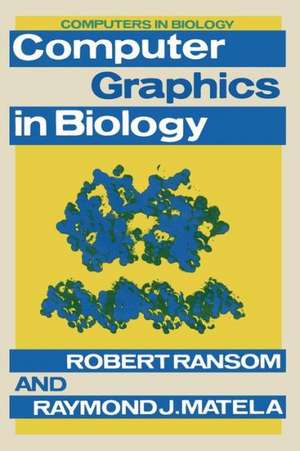Computer Graphics in Biology: Computers in Biology Series
Autor Robert Ransom, Raymond J. Matelaen Limba Engleză Paperback – 25 noi 2012
Preț: 383.93 lei
Nou
Puncte Express: 576
Preț estimativ în valută:
73.47€ • 76.86$ • 61.03£
73.47€ • 76.86$ • 61.03£
Carte tipărită la comandă
Livrare economică 03-17 aprilie
Preluare comenzi: 021 569.72.76
Specificații
ISBN-13: 9781468414929
ISBN-10: 1468414925
Pagini: 224
Ilustrații: XII, 212 p. 59 illus.
Dimensiuni: 155 x 235 x 12 mm
Greutate: 0.32 kg
Ediția:Softcover reprint of the original 1st ed. 1986
Editura: Springer Us
Colecția Springer
Seria Computers in Biology Series
Locul publicării:New York, NY, United States
ISBN-10: 1468414925
Pagini: 224
Ilustrații: XII, 212 p. 59 illus.
Dimensiuni: 155 x 235 x 12 mm
Greutate: 0.32 kg
Ediția:Softcover reprint of the original 1st ed. 1986
Editura: Springer Us
Colecția Springer
Seria Computers in Biology Series
Locul publicării:New York, NY, United States
Public țintă
ResearchCuprins
1. An Introduction to Computer Graphics.- 1.1 The beginnings of computer graphics.- 1.2 What is computer graphics?.- 1.3 Computer graphics and biology.- 1.4 The elements of a computer graphics system.- 1.5 Computer graphics in perspective.- 1.6 References.- 2. Graphics Hardware.- 2.1 An overview.- 2.2 Input devices.- 2.3 Display devices.- 2.4 Display processors.- 2.5 The computer.- 2.6 References and bibliography.- 3. Graphics Software.- 3.1 Connecting computers and graphic devices.- 3.2 Graphics software packages.- 3.3 Graphics packages on mini computers and mainframe computers.- 3.4 Microcomputer graphics software.- 3.5 Graphics workstations.- 3.6 The applications program.- 3.7 References and bibliography.- 4. Two-dimensional Graphics.- 4.1 The elements of two-dimensional transformations.- 4.2 Representation of points.- 4.3 Straight line transformations.- 4.4 Rotation.- 4.5 Reflection.- 4.6 Multi-operation transformations (composition).- 4.7 Two-dimensional homogeneous coordinates.- 4.8 Two-dimensional rotation about an arbitrary axis.- 4.9 References.- 5. Three-dimensional Graphics.- 5.1 Basic concepts.- 5.2 Three-dimensional homogeneous coordinates.- 5.3 Three-dimensional scaling.- 5.4 Three-dimensional shearing.- 5.5 Three-dimensional rotations.- 5.6 Reflection in three dimensions.- 5.7 Three-dimensional translation.- 5.8 Three-dimensional rotation about an arbitrary axis.- 5.9 Projections.- 5.10 Conclusions.- 5.11 References.- 6. Hidden Lines and Hidden Surfaces.- 6.1 An introduction to hidden lines and surfaces.- 6.2 A simple hidden lines algorithm.- 6.3 The Galimberti and Montanari algorithm.- 6.4 The hidden surface problem.- 6.5 A preliminary classification.- 6.6 Surface representation and hidden surface methods.- 6.7 Conclusions.- 6.8 References and bibliography.- 7. Graphical Representation of Biological Data.- 7.1 Introduction.- 7.2 Graphs and histograms.- 7.3 Point plots and transforms.- 7.4 Graphics data structures.- 7.5 A data structure for hidden lines treatment.- 7.6 References.- 8. Reconstruction Methods for Cell Systems.- 8.1 Tissue reconstruction.- 8.2 The role of computer graphics.- 8.3 Input of data.- 8.4 Two-dimensional analyses.- 8.5 Three-dimensional reconstruction.- 8.6 Three-dimensional reconstruction of neurones (CELL).- 8.7 Three-dimensional reconstruction of non-neural tissue (RECON).- 8.8 Other three-dimensional reconstruction programs.- 8.9 References and bibliography.- 9. Image Capture and Image Analysis.- 9.1 Biological images.- 9.2 Image capture devices.- 9.3 Analysis of periodic images.- 9.4 The Joyce-Loebl Magiscan.- 9.5 Reconstruction from X-ray data.- 9.6 References and bibliography.- 10. Molecular Graphics.- 10.1 An introduction to molecular graphics.- 10.2 Components of a molecular graphics system.- 10.3 Molecular data.- 10.4 Examples of molecular graphics packages.- 10.5 Some existing systems.- 10.6 References and bibliography.- 11. Simulation and Animation.- 11.1 Moving pictures.- 11.2 Hardware for real-time animations.- 11.3 Concepts of graphic animation.- 11.4 Dynamic graph construction.- 11.5 Simulation of cell division and cell interaction processes.- 11.6 Animation of genetic events.- 11.7 References and bibliography.- Appendix 1: Matrix Manipulations.- A1.1 Basic definitions.- A1.2 Vectors.- A1.3 Matrix addition.- A1.4 The trace of a matrix.- A1.5 The determinants of a matrix.- A1.6 Multiplication by a scalar.- A1.7 Matrix multiplication.- A1.8 References.- Appendix 2: A Graphics Glossary.















